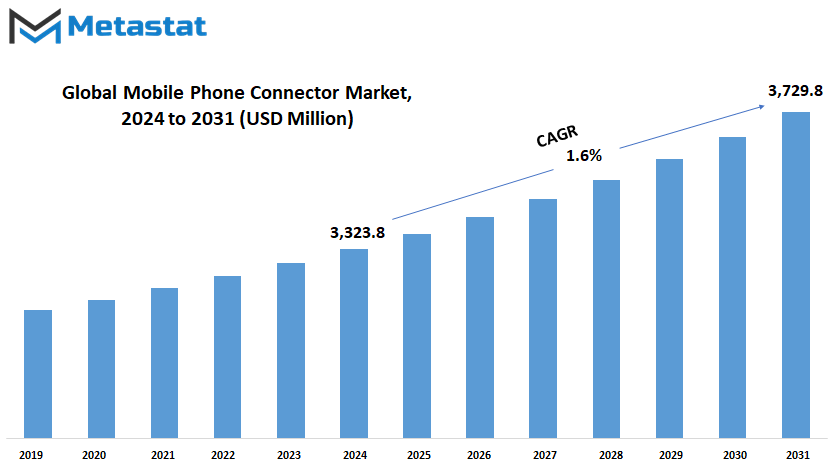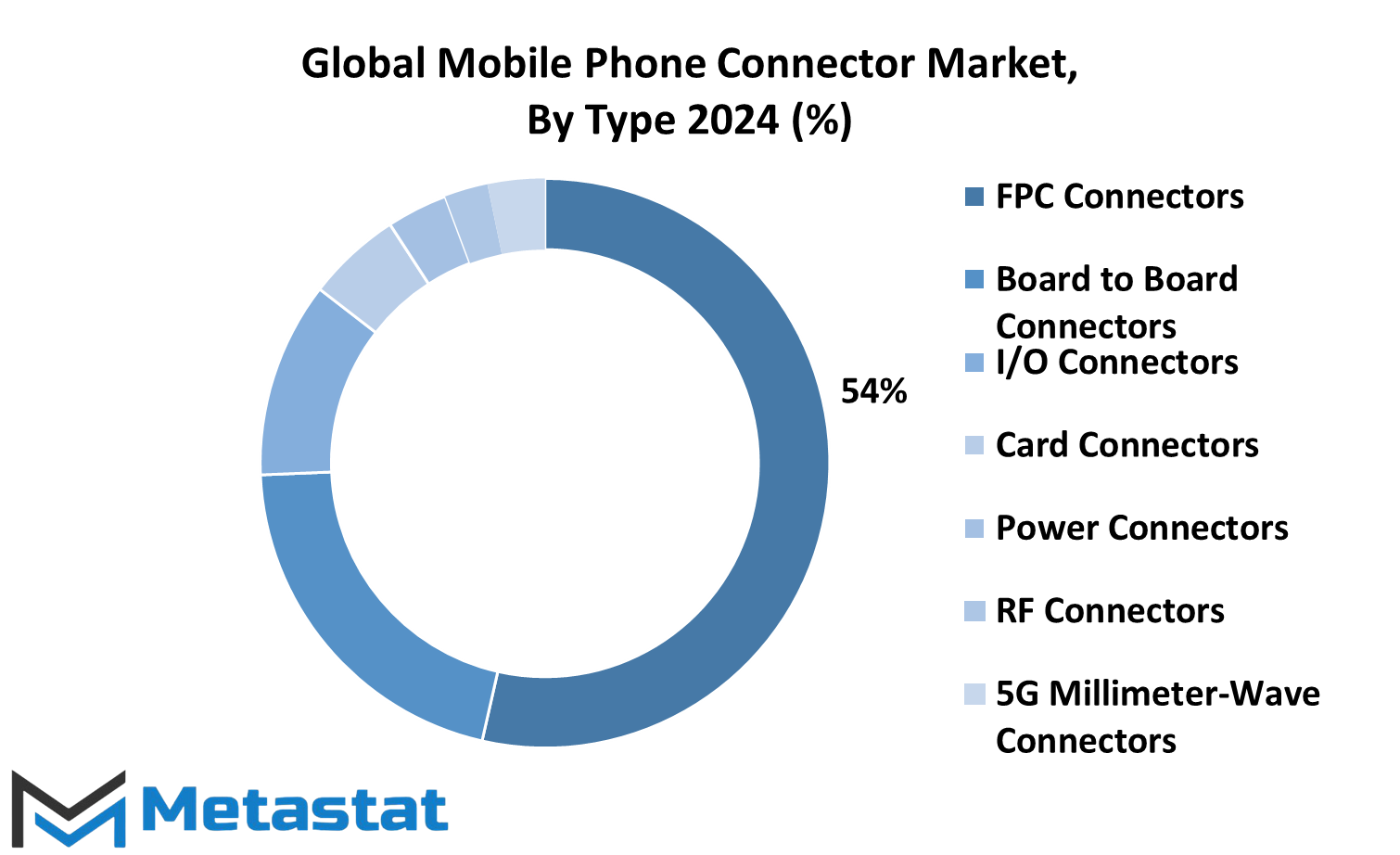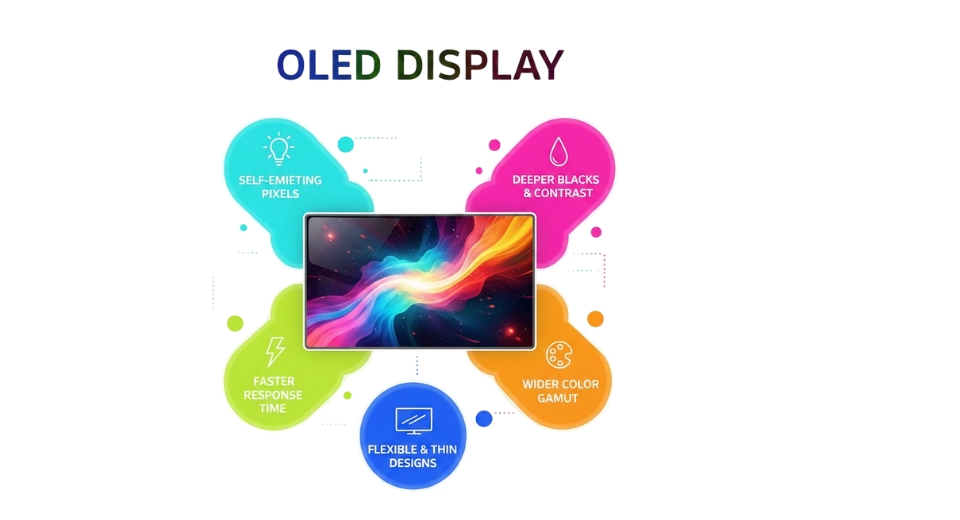MARKET OVERVIEW
The Global Mobile Phone Connector market is going to be huge, and the industry is going to play a very important role in the future of mobile communication technology. These connectors act as the spine of mobile devices, allowing integration of different components that provide reliable connectivity and efficient performance. The changes across this industry's landscape are spurred by advances in technology, consumer demand, and innovations in manufacturing processes.
The biggest and most important application of the mobile phone connector is to link various inner components in the phone, such as batteries, screens, and cameras, or outer accessories like chargers and headphones. Quickly evolving mobile technology will drive higher-speed connector requirements for better data transfer rates, increased power efficiency, and durability. Innovations in materials and design will be needed to provide solutions for such requirements.
The Global Mobile Phone Connector market manufacturers will now focus their attention on developing connectors that would complement the upcoming trends in the mobile industry. Slimmer and more compact gadgets would create demand for smaller and more efficient connectors. Besides, the increasing popularity of wireless technology is going to affect the design and functionality of the mobile phone connectors. This could lead to companies investing in research and development to come up with connectors that can support wireless technologies for charging and data transfer.
In the next few years, the fast-growing adoption of 5G technology is believed to make a remarkable influence on the Global Mobile Phone Connector market. With increased usage, mobile devices will need connectors that can handle higher frequencies and increased loads of data transfer. This would spur manufacturers to innovate and come up with connectors supporting the enhanced capabilities of the 5G-enabled devices. This shall be focused on ensuring stable and high-speed connections and maintaining energy efficiency.
Another important factor that will drive the future of the Global Mobile Phone Connector market is environmental sustainability. With the growing concern for the environment, the trend will shift towards the development of green connectors. This will pertain to the utilization of recyclable materials and energy-efficient processes in manufacturing methods. The demand for high-performance connectors has to be catered to while ensuring sustainable methods of production by companies.
The competitive landscape of the global mobile phone connector market will be a driver for companies to embrace new technologies and strategies in a bid to remain competitive within their respective markets. This will heighten the partnership/collaboration of both parties in leveraging their individual strengths toward the innovation of solutions that better meet the dynamic needs of the mobile industry. Besides, mergers and acquisitions are likely to take place further in consolidating the market by enhancing the capabilities of leading players.
At the very top, the Global Mobile Phone Connector market shall be central to the fate of mobile technology. With innovation, sustainability, and efficiency at the forefront, the industry shall seek to develop advanced connectors that fit the modern mobile device. The role of the mobile phone connectors will become only more important with enhanced technology to integrate and have better performance for mobile devices in the future. The future will embody the dynamic interplay between technological advancements and market strategies, leading to the shaping of a landscape that makes continuous evolution in mobile communication possible.
Global Mobile Phone Connector market is estimated to reach $3,729.8 Million by 2031; growing at a CAGR of 1.6% from 2024 to 2031.

GROWTH FACTORS
The Global Mobile Phone Connector market and its industry are going to be huge in the years to come and in forming the future of mobile communication technology. Basically, these connectors are referred to as the backbones of mobile devices since they give seamless integration between the different components, hence reliable connectivity and efficient performance. Improving technology, consumer demands, and innovations from manufacturers are going to impact the landscape of the industry.
A mobile phone connector serves as the interface between the internal components, such as batteries, screens, and cameras, and the external devices like chargers and headphones. Thus, rapidly evolving mobile technology will demand connectors that can support fast data transfer rates, enhanced power efficiency, and strength. Material innovations and design improvements will be critically required for this.
Manufacturers in the Global Mobile Phone Connector market will, therefore, strive to come up with connectors that would complement the emerging trends in the mobile phone industry. The growing trend of developing slim and compact mobile phones or devices will raise demand for connectors that are smaller and more efficient. Moreover, increasing prominence of wireless technology will impact the design and functionality of mobile connectors. This type of technologies in wireless charging and data transfer is likely to see companies investing in the research and development of connectors that can support them.
The growing adoption of 5G technology will raise demand in the global mobile phone connector market. As 5G networks increase, the associated mobile devices will need connectors that can sustain higher frequencies and loads of data transfer. Manufacturers will be driven to innovate and develop connectors that would complement the enhanced capabilities brought in by 5G-capable devices. This will focus on providing stable, high-speed connections while maintaining energy efficiency.
Another important factor that will dictate the future of the Global Mobile Phone Connector market is environmental sustainability. With increasing environmental consciousness, there would definitely be a move towards developing green connectors. This means using recyclable materials and following energy-efficient methods of production. A balance will have to be struck between meeting demand for high-performance connectors and the need for sustainable methods of production.
In the competitive landscape, companies will be driven to maintain their market positions with the adoption of new technologies and strategies in the Global Mobile Phone Connector market. More partnerships and collaborations are foreseen as the companies seek to leverage each other's strengths in developing innovative solutions that meet the changing needs of the mobile industry. Next in line could be mergers and acquisitions that would further consolidate the market and build up capability for the top players.
Finally, the Global Mobile Phone Connector market will turn out to be instrumental to what takes place in mobile technology for the future. Innovation, sustainability, and efficiency are the axis around which this industry would revolve to realize advanced connectors that live up to the demands of modern mobile devices. With the very fast and rapid advancement of technology, the mobile phone connectors will play a very large role in ensuring the integration and working of these devices in tandem. Shaping this landscape, which will be giving support to the evolution continuously going on in the field of mobile communication, will be complex interplay between technological trends and market strategies in the future.
MARKET SEGMENTATION
By Type
The Global Mobile Phone Connector market is going to grow significantly and transform in the next few years. With rapid evolution in mobile technology, this market will form a very vital component in connectivity infrastructure for mobile devices. By type, the market is inked into FPC connectors, board-to-board connectors, I/O connectors, card connectors, power connectors, RF connectors, and 5G millimeter-wave connectors. All these play a different role in the functioning of the mobile phone.
FPC Connectors will become essential in any future design of mobiles that allows flexibility and efficiency when connecting circuit boards. These connectors are projected to shrink, but at the same time, they will also be more reliable, giving way to the new and upcoming slimmer and more powerful devices. Board-to-Board Connectors still has its role in the future as providing stable connections between the different parts of a phone’s hardware. Their focus will be on durability and data transmission rates, which are supposedly trying to improve and continuously get better as the demand grows for faster and more reliable mobile communication.
I/O connectors, which manage input and output functions, will continue to develop, not only to support new peripherals and technologies but also to ensure seamless interaction with a wide range of external devices. Card connectors for SIM cards and memory cards will further develop into newer and more advanced formats of cards that will enhance data storage and improve communications. Improvements in Power Connectors will be geared towards faster charging speeds and more efficient distribution of power due to a heightened trend of demanding more extended life and faster recharging of batteries.
The major role of RF Connectors will manifest with increased wireless communication technologies. They will be designed for higher frequencies with a low loss in signal so that high quality links can be created in urban areas. The Global Mobile Phone Connector market is going to be radically impacted with the onset of 5G technology. 5G Millimeter-Wave Connectors would be pervasive and would accommodate high-speed data transfer rates that 5G is touting to deliver. Such connectors would be developed in line with the strict requirements of 5G networks to ensure that these connectors can sustain the enormous loads of data being transferred.
Innovative products and adaptability will mark the Global Mobile Phone Connector market in times to come. Much attention from manufacturers will be on the development of connectors that are small, efficient, and will also be able to support the next generation of mobile technologies. As mobile phones continue to evolve, so do the connectors needed to keep them working, thus driving innovation in this very important aspect of the mobile industry. In the future, we will have an increasingly connected world; at the center of this change will be mobile phone connectors that ensure the devices communicate quickly, efficiently, and reliably.

By Application
The global Mobile Phone Connector market is poised to take a huge stake in the future of mobile technology. On the back of increasing demand for smartphones and feature phones, the requirement for efficient and reliable connectors will also surge. These connectors, being an integral part of various functions, such as charging, data transferring, and audio connections, are evolving to fulfill the increasing demands from modern devices.
Looking forward, there will be great strides that will be driven by a need for more compact and versatile devices in the market. Manufacturers of smartphones are always trying to advance their products to be thinner and more efficient. This in itself will spur new connector technology innovations, because connectors will be smaller and more integrated, thereby reducing space within the device while enhancing their functionality. This trend is very evident in the smartphone, where every millimeter counts.
These developments will further envelop feature phones as well, which are not as advanced as smartphones. Being an intrinsic part of the market, especially in developing regions, feature phones also come to require robust and cost-efficient connectors. The Global Mobile Phone Connector market will adapt to provide solutions that meet such requirements, making sure that feature phones stay relevant and reliable.
Wireless technology is going to be very vital in the future of mobile phone connectors. With increased application in wireless technologies for charging and data transfer, the requirement for physical connectors is likely to reduce. But the requirement for connectors remains in several applications, such as high-speed data transfer and in areas where applications on wireless technology are not viable. Hybrid solutions will develop in the market to include the best of both worlds: provide convenience due to wireless technology while having the reliability of traditional connectors.
Sustainability will also turn out to be one major driving factor of the future of the Global Mobile Phone Connector market. There will be a growing trend to lean toward environmentally friendly connectors besides efficient ones with increased awareness of green issues. Manufacturers will increasingly work on using recyclable materials and developing products that do minimal harm to the environment. This shift in strategy will benefit not only the environment but also prove to be a selling point with many consumers who are slowly becoming sensitive to sustainability.
In other words, the future of the Global Mobile Phone Connector market seems to be turbulent and innovative. Bringing several improvements to the sector, modern technology will incorporate wireless solutions while giving due importance to sustainability, in an effort to go hand-in-glove with users of both smartphones and feature phones. The market will definitely develop innovative solutions to ensure that mobile devices run glitch-free, with demand increasing for more efficient, compact, and environmentally-friendly connectors.
|
Report Coverage |
Details |
|
Forecast Period |
2024-2031 |
|
Market Size in 2024 |
$3,323.8 million |
|
Market Size by 2031 |
$3,729.8 Million |
|
Growth Rate from 2024 to 2031 |
1.6% |
|
Base Year |
2022 |
|
Regions Covered |
North America, Europe, Asia-Pacific Green, South America, Middle East & Africa |
REGIONAL ANALYSIS
The Global Mobile Phone Connector market is poised to witness exponential growth in the coming few years, backed by technological advancements with the growing demand for mobile devices. A regional breakdown highlights how each geographical segment will grow at different rates because of the underlying differences in market dynamics and consumer needs across geographies.
North America will be powered by the US, Canada, and Mexico. The US is more likely to dominate the market due to its already developed technological infrastructure and innovation taking place in the field of mobile technology. In Canada and Mexico, growth will be further championed by the rapid adoption of smartphones and the critical need for improved connectivity solutions.
In the future, the Europe market, including the UK, Germany, France, Italy, and the Rest of Europe, will further increase due to demand in the region for good quality electronic components and strict standards in the mobile market. Germany and the UK are expected to dominate on account of a large manufacturing industry and a particular focus on development. France and Italy will also show major contribution in this particular segment due to high consumer demand and a need for advanced mobile devices.
The most dynamic market in this sector will be the Asia-Pacific region, segmented into India, China, Japan, South Korea, and the Rest of Asia-Pacific. With large production capacity and new technological developments, China—being the major manufacturing hub—will drive the market. Fast growth will be shown in India, driven by its surging smartphone market and growing internet reach. Japan and South Korea will still be major contributors in the future because both countries have well-developed technology sectors with strong consumer demand for new innovations related to mobile devices.
South America will continue to grow steadily, driven by Brazil and Argentina, while the Rest of South America will contribute as well. The large population in Brazil and increasing smartphone usage will drive demand for mobile phone connectors. Argentina is also expected to grow due to increased consumer awareness and adoption of advanced mobile technologies.
The Middle East & Africa, segmented into GCC Countries, Egypt, South Africa, and the Rest of Middle East & Africa, will register moderate growth. Of these, the GCC countries focusing on modernization and the adoption of technology—will lead the regional market. Next in line will be Egypt and South Africa, due to increasing mobile penetration and resultant demand for reliable connectivity solutions.
Moving ahead, the Global Mobile Phone Connector market will continue its course with regional trends and technology. Each geographical segment will present its own set of challenges and opportunities that will define the future of the market. With improved connectivity, advanced mobile experience, and technological innovation, this market will be driven on a pattern of stable growth reflective of changing and dynamic consumer needs across the world.
COMPETITIVE PLAYERS
On the basis of such factors, the Global Mobile Phone Connector market is projected to see remarkable growth in the forthcoming years, driven by innovation in technology and increasing demand for smartphones. Some leading players dominate the industry, including Advanced Connectek Inc. (ACON), Alps Electric, Electric Connector Technology Co., Ltd., Foxconn Technology Group, Hirose Electric, I-PEX Inc., Japan Aviation Electronics Industry, Ltd., JST Mfg. Those at the forefront in this market are Co., Ltd., LS Mtron Ltd., Luxshare Precision Industry Co., Ltd., Molex, LLC, Panasonic Corporation, Shanghai Laimu Electronics Co., Ltd., Shenzhen Linkconn Electronics Co., Ltd., SMK Corporation, TE Connectivity, UJU Electronics Co., Ltd., Rosenberger, Amphenol Corporation, and Kyocera Corporation.
It will see new designs that primarily reduce the size and increase the efficiency of the component to cater to the ever-growing demand of a modern-day smartphone. As future smartphones continue to push boundaries, so is the demand for next-generation connectors that can answer these requirements: faster data transfer rates, ruggedness, and power efficiency. Key industry players will most likely be at the forefront in the development of such next-generation connectors, making sure their designs are future-compatible with 5G and other emerging technologies.
This will even get better in the future where mobile phone connectors are integrated into other smart devices. In light of this, such connectivity will give the experience more versatile and user-friendly features, further improving customer demand. This would mean that companies have to invest a great deal in research and development to be competitive and, hence, set up a dynamic landscape of innovation.
Moreover, sustainability will turn out to be a major issue in the Global Mobile Phone Connector market. With environmental concerns scaling up, manufacturers will eventually focus on eco-friendly materials and processes. This turns to sustainability not only for the sake of compliance but to tap into the emerging environment-conscious market.
Another important factor driving the market will be the increasing adoption of wireless technologies. Even as traditional connectors continue to find a vital place, there will be an equivalent requirement for wireless charging and data transfer solutions. Companies that can manage this really well will have an edge, catering to different and wide-ranging consumer preferences.
Advanced technologies, consumer needs, and the necessity of sustainable development will transform the Global Mobile Phone Connector market. These major players are well positioned to lead such changes, ensuring that the market remains vivid and continues to move toward the future. Further out in the future, the mobile phone connector will contribute even more to the user experience as a whole, mirroring the adaptability and commitment to innovation in the industry.
Mobile Phone Connector Market Key Segments:
By Type
- FPC Connectors
- Board to Board Connectors
- I/O Connectors
- Card Connectors
- Power Connectors
- RF Connectors
- 5G Millimeter-Wave Connectors
By Application
- Feature Phones
- Smart Phones
Key Global Mobile Phone Connector Industry Players
- Advanced Connectek Inc. (ACON)
- Alps Electric
- Electric Connector Technology Co., Ltd.
- Foxconn Technology Group
- Hirose Electric
- I-PEX Inc.
- Japan Aviation Electronics Industry, Ltd.
- JST Mfg. Co., Ltd.
- LS Mtron Ltd.
- Luxshare Precision Industry Co., Ltd.
- Molex, LLC
- Panasonic Corporation
- Shanghai Laimu Electronics Co., Ltd.
- Shenzhen Linkconn Electronics Co., Ltd.
- SMK Corporation
WHAT REPORT PROVIDES
- Full in-depth analysis of the parent Industry
- Important changes in market and its dynamics
- Segmentation details of the market
- Former, on-going, and projected market analysis in terms of volume and value
- Assessment of niche industry developments
- Market share analysis
- Key strategies of major players
- Emerging segments and regional growth potential








 US: +1 3023308252
US: +1 3023308252






